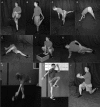Athletic Trainers' Effect on Population Health: Improving Access to and Quality of Care
- PMID: 30461294
- PMCID: PMC6464298
- DOI: 10.4085/1062-6050-219-17
Athletic Trainers' Effect on Population Health: Improving Access to and Quality of Care
Abstract
Context: The scope of athletic training practice combined with the magnitude of scholastic athletic injuries means that the scholastic athletic trainer (AT) is uniquely positioned to positively affect the overall health care of this population. The AT is equipped to serve in the prevention and primary management of injuries and return to activity of scholastic athletes. However, to optimize the musculoskeletal health of all athletes within a given setting, the gaps in clinical care must be continuously evaluated. Quality improvement (QI) approaches are often used to establish a framework for delivering care that promotes the best health status of the targeted population.
Objective: To describe the creation, implementation, and early results of a QI initiative aimed at advancing the health of the scholastic athletes served in the Greenville County, South Carolina, school district.
Design: Cohort study.
Patients or other participants: A total of 49 793 athletes.
Main outcome measure(s): The QI framework consisted of a process that documented the magnitude of athletic injuries, established risk factors for injury, defined intervention steps for at-risk athletes, and evaluated the QI process before and after implementation. The results were regularly reported to participating stakeholders, including ATs, athletic directors, coaches, parents, and athletes.
Results: After the QI process, injury rates decreased (absolute risk difference between the 2011-2012 and 2016-2017 academic years = 22%) and resources were more strategically allocated, which resulted in a decrease in health care costs of more than 50%.
Conclusions: Collectively, the QI framework as described provides a systematic process for empowering the AT as the foundation of the scholastic sports medicine team.
Keywords: injury prevention; scholastic athletic injuries; tertiary care.
Figures




Similar articles
-
High School Athletic Trainer Services for Knee Injuries.J Athl Train. 2018 Oct;53(10):956-964. doi: 10.4085/1062-6050-48-17. Epub 2018 Oct 9. J Athl Train. 2018. PMID: 30299158 Free PMC article.
-
Self-reported comfort of collegiate athletes with injury and condition care by same-sex and opposite-sex athletic trainers.J Athl Train. 2007 Jan-Mar;42(1):106-12. J Athl Train. 2007. PMID: 17597951 Free PMC article.
-
National Collegiate Athletic Association Division I Certified Athletic Trainers' Perceptions of the Benefits of Sport Psychology Services.J Athl Train. 2016 May;51(5):398-405. doi: 10.4085/1062-6050-51.5.13. Epub 2016 May 9. J Athl Train. 2016. PMID: 27159188 Free PMC article.
-
Psychological Interventions Can Reduce Injury Risk in Athletes: A Critically Appraised Topic.J Sport Rehabil. 2022 Feb 1;31(2):224-229. doi: 10.1123/jsr.2020-0315. Epub 2021 Sep 15. J Sport Rehabil. 2022. PMID: 34525450 Review.
-
Quality Improvement in Athletic Health Care.J Athl Train. 2017 Nov;52(11):1070-1078. doi: 10.4085/1062-6050-52.10.15. Epub 2017 Nov 10. J Athl Train. 2017. PMID: 29125782 Free PMC article. Review.
Cited by
-
Factors Influencing Athletic Training Services in California Secondary Schools: A 5-Year Update.J Athl Train. 2024 Nov 1;59(11):1132-1138. doi: 10.4085/1062-6050-0187.24. J Athl Train. 2024. PMID: 38835328
-
Athletic Trainers' Perceptions of and Experience with Social Determinants of Health.Int J Environ Res Public Health. 2023 Apr 21;20(8):5602. doi: 10.3390/ijerph20085602. Int J Environ Res Public Health. 2023. PMID: 37107884 Free PMC article.
-
Financial Impact of Embedded Injury-Prevention Experts in US Army Initial Entry Training.J Athl Train. 2023 Jun 1;58(6):511-518. doi: 10.4085/1062-6050-0353.22. J Athl Train. 2023. PMID: 36583956 Free PMC article.
-
Secondary School Athletic Trainers' Perceptions of the Influence of Social Determinants of Health and Socioeconomic Status on Clinical Management Decisions.J Athl Train. 2024 Apr 1;59(4):388-393. doi: 10.4085/1062-6050-0445.22. J Athl Train. 2024. PMID: 37459372 Free PMC article.
-
Research at the Point of Care: Using Electronic Medical Record Systems to Generate Clinically Meaningful Evidence.J Athl Train. 2020 Feb;55(2):205-212. doi: 10.4085/1062-6050-113-19. Epub 2020 Jan 14. J Athl Train. 2020. PMID: 31935140 Free PMC article.
References
-
- National Federation of State High School Associations. 2015–2016 high school athletics participation survey. National Federation of State High School Associations Web site. 2018 www.nfhs.org/ParticipationStatistics/PDF/2015-16_Sports_Participation_Su... Published 2016. Accessed March 1.
-
- Institute of Education Sciences. Fast facts: back to school statistics. National Center for Education Statistics Web site. 2018 https://nces.ed.gov/fastfacts/display.asp?id=372 Published 2017. Accessed March 24.
-
- American College of Sports Medicine. Current comment from the American College of Sports Medicine. August 1993: the prevention of sports injuries of children and adolescents. Med Sci Sports Exerc. 1993;25(suppl 8):1–7. - PubMed
MeSH terms
LinkOut - more resources
Full Text Sources
Medical

